Varnish protects wood from scratches, moisture, and dents. But, after a while, the finish gets old and must be removed. So, how to remove varnish from wood?
To remove varnish from wood, sand it off, use a paint-stripping compound, or paint or lacquer thinner.
Sanding is the best method to remove it as it will also smoothen and make the wood paint-ready immediately.
Can You Remove Varnish From Wood Without Sanding?
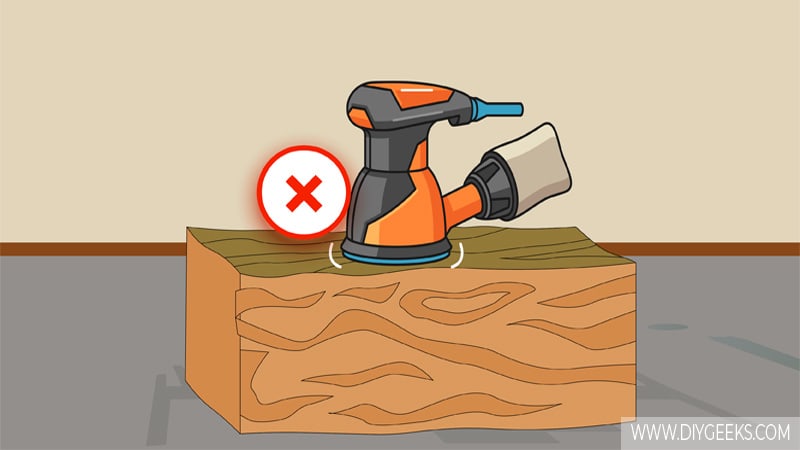
You can remove varnish from wood without sanding by using a paint-stripping compound or paint thinner. These products have active ingredients that will dissolve and remove the varnish finish from the wood.
The paint-stripping compound will dissolve the finish by breaking the bond between the paint particles and the surface. Within a few minutes, you can scrape the varnish coating off the surface.
The paint-stripping compound and paint thinner will damage or discolor the wooden surface if you leave them on for too long. After using a liquid paint remover, you must wait until the wood is dry before re-painting it, which can delay your painting project.
On the other hand, sanding will remove the varnish finish and smoothen the wooden surface by removing imperfections and bumps and making it paint-ready. You can immediately re-paint wood if you sand the existing finish off.
Can You Remove Varnish Without Removing Paint Underneath it?
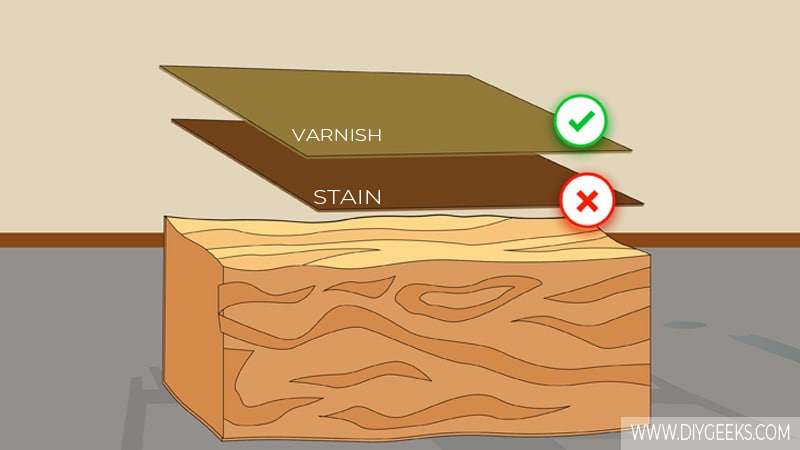
You can remove varnish without removing paint underneath it by using #0000 steel wool and a mixture of lacquer thinner and denatured alcohol.
Mix lacquer thinner with denatured alcohol and apply the mixture over the finish. Within 10 seconds, use #0000 steel wool to remove the varnish from the surface.
Once the varnish is removed, immediately use a clean rag to remove the mixture from the wood or it will remove the paint (or wood stain) underneath too.
A mixture of lacquer thinner and denatured alcohol will produce a thick paint remover that is strong enough to remove varnish, but too thick to penetrate wood quickly.
Since the mixture can’t penetrate the wood quickly due to its thick nature, the paint (or wood stain) underneath won’t be affected.
However, if you aren’t experienced enough it’s best to remove the entire finish and re-apply it.
How To Remove Varnish From Wood?
To remove varnish from wood, do the following things.
- Sand the Varnish Off.
- Use Paint-stripping compound.
- Use Paint or Lacquer Thinner.
1. Sand the Varnish Off
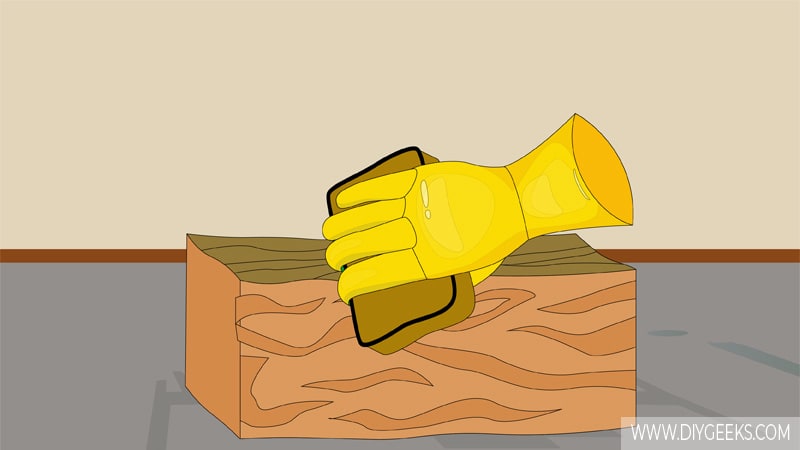
Sanding will remove the varnish finish from the wood and make the surface paint-ready. The abrasive side of the sandpaper will gradually wear off the finish until it’s completely removed.
To remove varnish, use coarse-grit sandpaper (40-grit) or medium-grit sandpaper (100-grit). Don’t use fine-grit sandpaper (220-grit or higher) as it isn’t abrasive enough to remove finishes from surfaces.
Sanding will also remove imperfections and bumps from the surface.
The tools you need for this project are listed below.
- Sandpaper.
- A pair of gloves
- Rags
- A vacuum or duster
- An orbital sander for large surfaces.
To remove varnish by sanding, do the following things.
- Clean the surface to remove dust, dirt, or debris that can dull (clog) the sandpaper.
- Use medium-grit sandpaper (100-grit). You can manually sand the surface or use a power sander for large surfaces.
- Sand for five (5) minutes and inspect the finish.
- If the varnish finish is wearing off, continue sanding with medium-grit sandpaper. If the varnish finish isn’t wearing off, use coarse-grit sandpaper (40-grit).
- Sand until the entire finish is removed.
- Use a vacuum to remove dust.
- Re-paint wood if needed.
2. Use Paint-stripping Compound
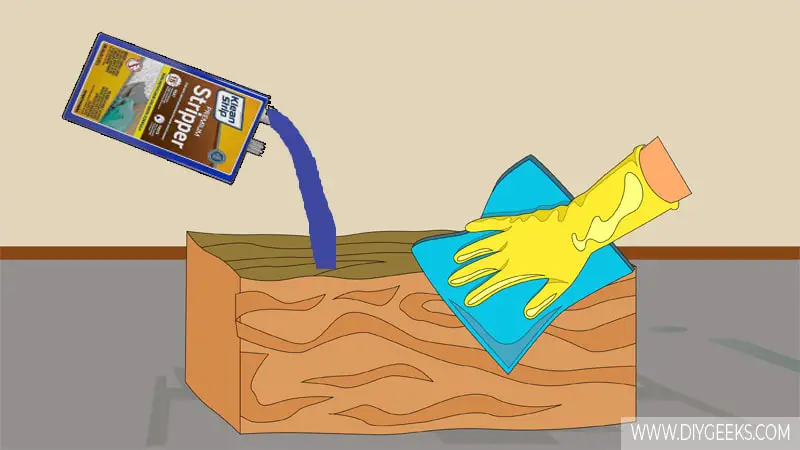
A paint-stripping compound will penetrate the finish, break the bond between the paint particles and the surfaces, and dry underneath the finish. Once the paint-stripping compound dries, you can scrape it off and the finish will come off too.
The advantage of this method is that is quick and will remove all types of varnish. The disadvantage of this method is that it can damage the wooden surface if left for too long, and you must wait until the wood dries before re-painting it.
The tools you need for this project are listed below.
- Paint stripper (chemical-based or water-based)
- A paint scraper or putty knife
- Rags
- Steel wool (#0000 wool pad)
- A pair of gloves
- Mineral spirits
Here’s a step-by-step guide to this.
- Put on gloves and safety goggles.
- Pour the paint-stripping compound over the varnish finish.
- Wait a few minutes for the paint-stripping compound to work (The wait time is indicated on the container).
- Once the finish starts to bubble up, scrape it off with a paint scraper or #0000 steel wool.
- Use diluted mineral spirits to remove the paint-stripping compound residue from the wood. If you don’t remove the residue, the wood surface will get damaged or discolored.
- Clean the wood with water and allow it to dry.
Tip: When using a paint-stripping compound always follow the manufacturer’s instructions.
3. Use Paint or Lacquer Thinner
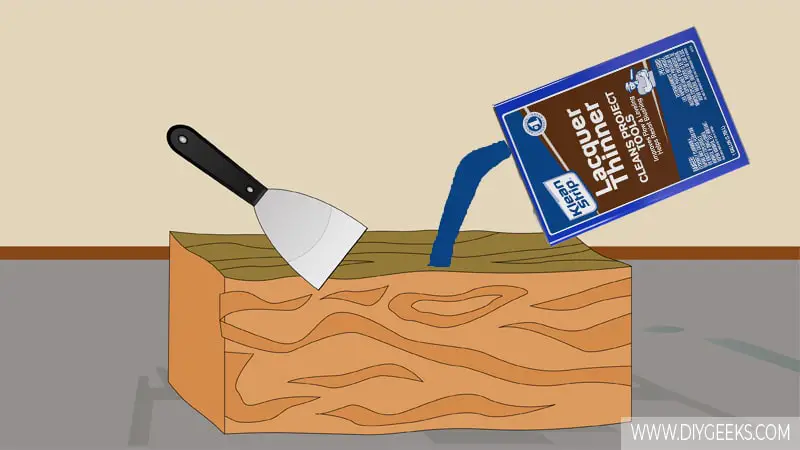
Paint or lacquer thinner is primarily designed for thinning paints or lacquer sealers, but you can use it to remove varnish finishes, too.
The tools you need for this project are listed below.
- Lacquer thinner (denatured alcohol also works)
- Rags
- Plastic putty knife
- A plastic container
- A pair of work gloves
Here’s how to do it:
- Use safety goggles.
- Pour lacquer thinner into a plastic container.
- Dampen a rag with lacquer thinner.
- Use the dampened rag (not soaked) to wipe the finish repeatedly.
- Wait for a few minutes.
- When you start to see changes in the color or appearance of the finish, scrape it off using a plastic putty knife.
How Soon After Removing Varnish Can You Re-paint Wood?
You must wait around 30 minutes to 24 hours after removing varnish before re-painting wood. The exact wait time depends on the removal method you used.
For instance, you can re-paint wood within 30 minutes if you remove varnish by sanding. Sanding doesn’t wet the wood and will make it paint-ready immediately.
However, you must wait around 24 hours if you remove the finish with a paint-stripping compound or paint thinner.
These two products will dampen the wooden surface, and you must clean the wood with water to remove their residue, so you must wait until the wood is dry before painting it.
Other Products You Can Use:
Vinegar
You can remove varnish with vinegar. Vinegar is a mild acid and will dissolve and liquefy the finish, making it easier to scrape it off.
Acetone
You can remove fresh (or wet) varnish coating with acetone. Acetone will remove wet varnish spills as the sealer is still in its drying stage and hasn’t properly bonded to the surface, so acetone will remove it.
Acetone can’t remove dried (or cured) varnish.
Turpentine
You can remove acrylic varnish with turpentine, but you can remove oil-based varnish. Turpentine is strong enough to remove water-based finishes, but can’t remove oil-based finishes.


